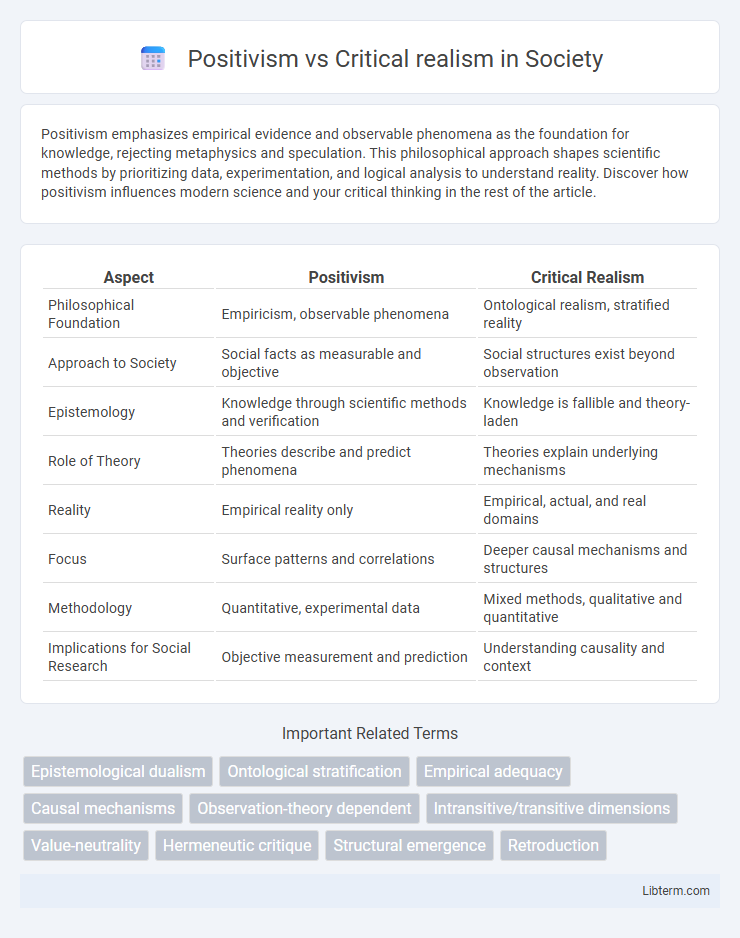Positivism emphasizes empirical evidence and observable phenomena as the foundation for knowledge, rejecting metaphysics and speculation. This philosophical approach shapes scientific methods by prioritizing data, experimentation, and logical analysis to understand reality. Discover how positivism influences modern science and your critical thinking in the rest of the article.
Table of Comparison
| Aspect | Positivism | Critical Realism |
|---|---|---|
| Philosophical Foundation | Empiricism, observable phenomena | Ontological realism, stratified reality |
| Approach to Society | Social facts as measurable and objective | Social structures exist beyond observation |
| Epistemology | Knowledge through scientific methods and verification | Knowledge is fallible and theory-laden |
| Role of Theory | Theories describe and predict phenomena | Theories explain underlying mechanisms |
| Reality | Empirical reality only | Empirical, actual, and real domains |
| Focus | Surface patterns and correlations | Deeper causal mechanisms and structures |
| Methodology | Quantitative, experimental data | Mixed methods, qualitative and quantitative |
| Implications for Social Research | Objective measurement and prediction | Understanding causality and context |
Introduction to Positivism and Critical Realism
Positivism emphasizes empirical observation and scientific methods as the foundation for knowledge, asserting that reality is objective and measurable through sensory experience. Critical realism acknowledges an objective reality but highlights the importance of underlying structures and mechanisms that are not always directly observable, combining empirical investigation with theoretical interpretation. The key distinction lies in positivism's reliance on observable phenomena and critical realism's focus on deeper causal explanations beyond immediate data.
Historical Background and Development
Positivism emerged in the early 19th century through Auguste Comte, emphasizing empirical observation and scientific methods as foundations for knowledge. Critical realism, developed in the late 20th century by Roy Bhaskar, critiques positivism by integrating ontology with epistemology, highlighting that reality exists independently of human perceptions but can only be understood through scientific inquiry. The historical development of positivism laid the groundwork for empirical social sciences, while critical realism evolved as a response to address its limitations in explaining complex social phenomena.
Core Philosophical Assumptions
Positivism asserts that reality is objective and can be observed through empirical measurement, emphasizing observable phenomena and quantifiable data as the foundation for knowledge. Critical realism, by contrast, holds that reality exists independently of human perception but acknowledges that our understanding of it is socially constructed and mediated by theoretical interpretations. The core philosophical distinction lies in positivism's commitment to empirical verification versus critical realism's recognition of deeper causal mechanisms beyond immediate observation.
Ontology: Nature of Reality
Positivism asserts that reality is objective, singular, and independent of human perception, emphasizing observable and measurable phenomena governed by natural laws. Critical realism posits that reality exists independently but is stratified into the empirical, actual, and real layers, recognizing both observable events and underlying mechanisms. While positivism focuses on facts accessible through sensory experience, critical realism acknowledges a deeper, structured reality shaped by causal powers beyond immediate observation.
Epistemology: Ways of Knowing
Positivism bases epistemology on observable, quantifiable facts, emphasizing empirical data and scientific methods as the sole ways of knowing reality. Critical realism argues that knowledge arises from understanding both the observable empirical domain and the underlying structures, acknowledging that reality exists independently of our perceptions but can only be imperfectly known. This epistemological stance integrates empirical evidence with theoretical interpretation to reveal causal mechanisms beyond surface phenomena.
Methodological Approaches
Positivism emphasizes quantitative methods and empirical observation, prioritizing measurable data to establish general laws and causal relationships. Critical realism combines empirical observation with an understanding of underlying mechanisms, advocating for both quantitative and qualitative methods to explore deeper social structures and causal powers. This approach encourages mixed methodologies that recognize the complexity of social phenomena beyond mere observable events.
Key Thinkers and Influential Works
Positivism, pioneered by Auguste Comte with his work "Course in Positive Philosophy" (1830-1842), emphasizes empirical observation and scientific methodology as the basis for knowledge. Critical realism, developed by Roy Bhaskar in "A Realist Theory of Science" (1975), critiques positivism by advocating for the recognition of underlying structures and mechanisms beyond observable phenomena. Both philosophical approaches significantly influence social science research paradigms, with positivism favoring measurable data and critical realism stressing ontological depth and explanatory power.
Strengths and Critiques of Positivism
Positivism offers strengths in its rigorous use of empirical data and scientific methods, enabling objective and replicable research findings. Critics argue that positivism's focus on observable phenomena limits its ability to capture complex social realities, often neglecting subjective experiences and deeper causal mechanisms. This has led to calls for approaches like critical realism, which emphasize underlying structures and the interplay between observable events and unobservable processes.
Strengths and Critiques of Critical Realism
Critical Realism offers a robust framework that acknowledges the existence of an objective reality while recognizing the influence of social structures and human agency, making it highly effective for complex social science research. Its strength lies in the depth of causal explanation, bridging the gap between positivist empirical data and interpretivist understanding of human behavior, which allows for a comprehensive analysis of underlying mechanisms. Critics argue that Critical Realism can be overly abstract and difficult to operationalize in empirical studies, sometimes leading to challenges in practical application and empirical validation.
Practical Implications in Research
Positivism emphasizes objective measurement and quantifiable data, promoting standardized methodologies that ensure replicability and statistical validation in research. Critical realism, by contrast, advocates for understanding underlying structures and causal mechanisms, encouraging mixed methods to capture both observable phenomena and deeper contextual dynamics. This pragmatic divergence influences research design, with positivism favoring hypothesis testing and critical realism supporting theory development through iterative exploration.
Positivism Infographic

 libterm.com
libterm.com